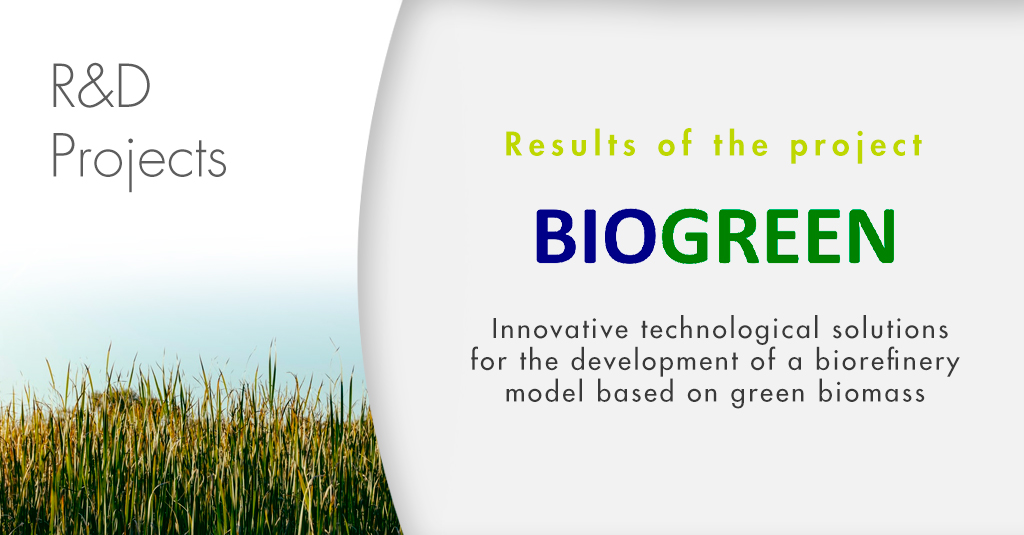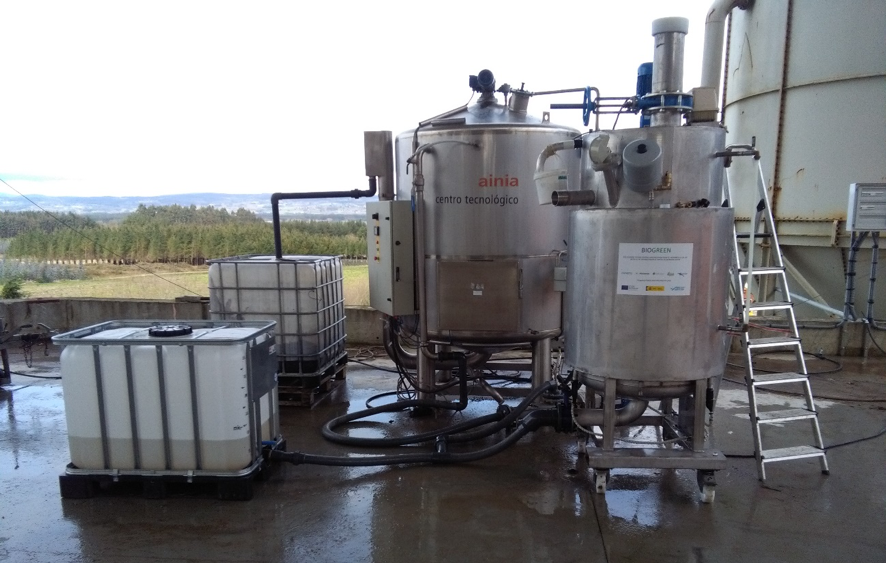Innovative technological solutions for the development of a biorefinery model based on green biomass
Execution period: October 2016 – March 2019
Status: Completed
Project Aims:
The general objective of the BIOGREEN project was the development of a green biorefinery for the treatment of surplus agricultural waste and the generation of energy and bioproducts within agro-industrial environments. This objective pursued several goals: to contribute to the advancement toward a circular and decarbonized economy, the development of endogenous technologies, and the integration of waste management with the generation of energy and products with high added value in agro-industrial environments.
With these aims, a process was outlined involving raw material specifications, subprocesses, and their integration and optimization as a whole; the optimization of a raw-material conditioning subprocess through the development of a pilot press system; and finally, the pilot assembly of a biorefinery model (hydrolytic digester + anaerobic digester), with subsequent validation at industrial scale.
The project was articulated through 6 modules, GalChimia being the leader of module 3 (Production of added-value compounds from the fiber fraction). The objectives related to each activity are detailed below.
Activity 1 – Raw material fractionation: Evaluation of the fractionation and processing of the raw material (green biomass) into its two main constituents: press-juice and press-cake.
Activity 2 – Anaerobic digestion process in two phases: Study of the two-phase anaerobic digestion of the press-juice obtained from biomass fractionation. Optimization of the process yields, maximizing the production of volatile fatty acids (VFAs) and biogas.
Activity 3 – Production of added-value compounds from the fiber fraction: Development and optimization of a process for the production of cellulose acetate from the green biomass press-cake. Evaluation of different lines of use of the biomass, based on chemical and/or enzymatic processes. Synthesis of membranes from the obtained cellulose acetate for separation applications.
Activity 4 – Development of the production process of polyhydroxyalkanoates (PHAs) in mixed culture. Study of the PHA production yield in mixed culture by feeding with the VFAs from the hydrolytic reactor. Construction and automation of a pilot system for PHA production. Development of a polymer recovery process at laboratory scale.
Activity 5 – Study of the use of digested material as fertilizer.
Activity 6 – Integration, modeling, and optimization of the process. Environmental and economic analyses. Definition and analysis of feasibility and business plan.
Project results:
The BIOGREEN project has successfully met the established objectives by achieving the following results:
- The plant species of greatest interest for the biorefinery model has been established from among those initially selected, taking into account technical and economic criteria, as well as avoiding interference with human and animal feed. The species with the greatest potential for the model was found to be ray-grass (genus Lolium), which was subsequently used as the basis for the rest of the project.
- Based on both laboratory and industrial scale tests, it has been possible to establish a protocol and press regime for green biomass, which has allowed the yield optimization of both cake and juice production. A press suitable for use at industrial scale was selected and operated, and its operational parameters adjusted to optimize the performance and operating costs.
- A hydrolytic reactor has been designed, constructed, and operated, which has enabled the first phase of the treatment of the press-juice obtained from ray-grass, as well as the extraction of VFAs for the PHA biosynthesis stage.
- A pilot plant has been set up and operated to evaluate the technical and economic feasibility of the BIOGREEN project, consisting of two reactors (the first one – hydrolytic, connected to a second one – methanogenic) connected in series. As such, ray-grass biomass was pressed for the recovery of a cake rich in cellulose, the juice fraction was processed in the reactors to obtain VFAs and biogas, and the digestate was recovered for further assessment from an agronomic point of view.
- Fertilization tests have been performed both in the laboratory and in the field, which have allowed the determination of the suitability of the digestate as a fertilizer, evaluating in parallel the costs and yields derived from its application.
- Cellulose acetate has been synthesized from the cake fraction extracted from ray-grass, and membranes of this material have been prepared, evaluating the best techniques and technologies available.
- Two reactors have been designed, built, and operated for the synthesis of PHAs from the VFAs extracted in the biorefinery. VFAs have been synthesized and the yields and costs associated with their production studied.
- Co-digestion tests have been carried out with other residues present nearby the location of the project that are also common in agricultural and agro-industrial environments, so as to improve the yields of the biorefinery as a whole and of the biogas production in particular. Based on these experiences, information has been obtained on possible substrate mixtures that may help optimize the biogas production.
- Finally, based on the technical results of each of the modules of the project, an integration model has been developed by evaluating costs and joint returns in terms of investment, as well as operation and maintenance. On this basis, a business model has been proposed for the development of the BIOGREEN biorefinery in the coming years, indicating possible points for improvement.
Project budget: 992,200.69 EUR
GalChimia thanks all the members and collaborators of the project BIOGREEN for their involvement and work, which have been key to obtaining the present results.
The project has been carried out in collaboration with the companies Norvento, Agroamb Prodalt, Syspro, and Idener, and the technological centers AINIA and CETIM. It has been funded by the Center for the Development of Industrial Technology (CDTI), the European Regional Development Fund (ERDF), and supported by the Spanish Ministry of Economy and Competitiveness.





